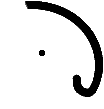Preview Web |
||||
Lower Body Composture Re-explaining David Lee's Counterfall Theory By Taylor Spalding I'm going to take a little dive into formalism to talk about lower body action in the swing. I do this with great caution because a tiny bit of extra thinking in golf leads one down the perilous path of concepts and ideals. And we want to be nowhere near conceptualization during the action of the swing itself. So I will try my best to paint this article with broad strokes and not have you read more into it than necessary. This particular aspect of swing has to do with the final instants of WANING action and the full measure or the WELTING action. New readers should review the Ten Actions. Those already familiar have discovered that each action is dependent upon the stability (or instability) of the previous action. Before we examine Lee's counterfall theory, lets go back to the previous actions of WALKING and WAGGLING to see how to compose the body in setup. A good composture is necessary to align the body, encourage comfort, and make the body more susceptible to the notion of efficiency. In The Secret of the Waggle we see how the upper body finds its composture through waggling. In this article we will examine lower body composture through walking. This issue has been touched on in another article titled A Piece on Walking. But here I want to put WALKING into the context of Lee's counterfall theory and explain why the lower body composture should be as I describe. See the review of David Lee's Gravity Golf. I'll get to the lower body composture key in a moment. First a little background. The idea for this article came to me as I was having a discussion with my friend Tim, a local PGA professional in the Cleveland area. I had been demonstrating The Golden Swing Thing™ to him when the conversation of footwork arose. The conversation revolved around the propensity of the amateur, in an effort to attain an inside to out club head path, to direct the leading edge of the down swing force through the left leg and into the ball of the left foot. Such activity has the tendency to create either a lunging motion or a pulling off motion.The former is caused by the left knee breaking down, the latter by the left knee resisting a break down. The key for the lower body is to get the momentum directed toward the outside of the left heel as the arms, club, and torso fall toward the ball. Lee's counterfall theory is intrinsic and wholly compatible with The Spalding Method in this regard. I like to explain it differently and demonstrate it with The Golden Swing Thing™. In my review of Lee's book I was fairly critical of his explanation of the theory and of his terminology. According to my friend Lobster (the formalist), a Golf Channel junkie, Lee explained it much better on Golf Talk Live. I would like to re-explain his theory by relating it directly to some of the things already described in Waking to the Orbit of Swing. Upon review of that article it becomes fairly obvious why Lee came up with the gravity lingo. Based on the Newtonian model of what would happen if the moon were to fall out of orbit, Lee's assumptions are one hundred percent correct. (Even though I slightly bashed Lee in the Public web, the more I talk about this guy the more I like him!) There is no "effort" in the moon crashing toward the Earth center. The acceleration is inevitable. The key to understanding David Lee's theory is to understand what is happening at the commencement of the counterfall. Let's go through the key actions. First there's the "heave" (the WHENING moment), then the "first release" (WANING), and finally the "counterfall" (commencement of WELTING). The counterfall actually begins a tad prior to the infinitely divisible moment between WANING and WELTING. See What's Between To and Fro? in the Public Web. As the body enters the freefall or gravity movement the True Center, by means of angular momentum, begins shooting energy directly out the other side. The moon, as it were, is in the upper right hand quadrant, therefore the True Center begins throwing energy into the lower left quadrant. The first affected area is the left hip. You will often hear teachers talk of "clearing the left hip." Well, that's the why and wherefore of it. Now here's the important part: Between the Earth and the Moon there is a vacuum of space. And if the moon were to fall out of orbit it would, after curling in for a time, make a beeline for the center of the Earth. In the golf swing we have all these body parts in the way. Therefore the momentum must be thrown around the center. Angular momentum! Now the first inkling of the momentum of the freefall shoots nearly directly out the other side of True Center. But as the mass begins falling around the center the fall must be responded to with a counter-clockwise shift if the True Center is to remain intact. The effect is such that, after the initial reaction in the left hip, the momentum makes its way toward the outside of the left heel and left of the target line. And that is the meaning of Lee's counterfall. My original complaint with Lee's explanation of the counterfall was that the amateur would attempt to time the counterfall and become disconnected altogether. This is especially true if the swinger is not making a WANING motion. If the swinger is accelerating the periphery instead of letting it slow down, a move to the left heel will not extricate him from his condition. He will have no choice but to fall back on his heels. The counterfall is purely instinctive component of the dynamic swing system. The counterfall can only be successful if its action is a reaction to the periphery of the swing system being called home to True Center. A great source of confusion in golf stems from how the observable physical aspects of this action play out in real time. David Lee, Jim McLean, and countless others have pointed out that the lower body begins its forward movement before the upper body has completed its backswing movement. Video analysis corroborates their conclusion. Yet it is nearly impossible to communicate this fact in a way that ends up being something useful to swing improvement seekers. Allow me to make an attempt. Let's imagine that the momentum of the backswing creates an imaginary arc. The black dot represents the True center.
In the last moments of WANING the momentum arc begins to curl severely.
Imagine that the moon is falling out of orbit. Would the moon follow its stable arc and, when finally losing its momentum, turn on a dime while heading for the center of Earth? Would it look like the diagram below?
No! It would curl in on its way toward earth. The earth would also curl out slightly as the center of the earth would move a wee bit toward the moon. The eventual collision however would take place very near to the space that the earth originally occupied. The counterfall is an activity that helps True Center maintain its space against the pull of the mass going around it during the smooth acceleration of WELTING. That is the obvious aspect of its nature. The more sublime aspect is that the counterfall prevents the True Center from that slight curl out toward the periphery. The only way this is possible is for a reaction to occur before the movement has finished the WANING motion. As the momentum of the periphery is curling in a reaction has started on the opposite side of True Center to prevent the True Center from curling out. We observe this and state that the lower body has made its movement forward while the upper body is still moving the opposite way. This may be true to observation, but in reality this is still one motion all interconnected by means of connection to the True Center. Lower Composture Key There are things that can be done in the setup to enhance the body's mechanical susceptibility. Lower body composture is mostly determined by the WALKING motion. In addition to gaining lower body composture by WALKING, presetting the balance points in the left foot can have a tremendous effect toward realizing the truth of the counterfall. My friend Tim agrees that the setup should work from the heels forward toward balance. A setup key for the left foot that he likes is this: After setting up to a balanced lower body position, lift the left big toe so that it touches the inside of the top of the shoe. This doesn't mean to lift the ball of the left foot off the ground. It's just a lower body composture cue to encourage the action to "post up" on the outside of the left heel when WELTING is imminent. Added 10/27/99: Allow me to make one modification to this method. Although a cornerstone of the Gravity Golf method, the term "outside of the left heel" is quite vague. For some swingers it should read "outside toward the left pinky toe." The paragraph to follow explains why. There is one variable in the counterfall that Mr. Lee has overlooked. The flaw in his logic is painfully obvious. His model of the counterfall is based upon a "pro speed swing." In the well connected and supple pro speed swing, the counterfall angle moves more severely to the left of the target line. Let me explain. The professional golfer in general achieves greater tensile connection and fuller arc. He or she is more supple than the weekend player. The result is greater through-swing velocity. In pure technical terms, a one mile per hour difference in swing velocity equates to plus or minus 1.4667 feet per second. His thirty degree rule is therefore valid only for the pro speed swing. Maxim: The greater the swing velocity, the greater the angle of the counterfall. Conversely, the lesser the swing velocity, the lesser the angle of the counterfall. For the average golfer, with a medium swing speed, a David Lee counterfall leads to pulling the ball. So a person with an average swing speed should be moving that counterfall more toward the left pinky toe. The key is to get to the outside of the left foot in balance. Every person has their own unique and ideal tempo and through-swing velocity.Therefore the nature of one's ideal counterfall is also unique. Keep in mind that a proper upper body composture is also necessary. In relation to the counterfall theory it is of utmost importance to maintain a supple left side connection. Excess tension will take away from the full mass of the left extension. Left side tension will reduce the weightiness of the extension and fool the right hand into believing that excess energy must be used to run the swing system. In truth, just a dash at the takeaway will suffice. See: Upper Body Composture and The Secret of the Waggle |
||||
|
Copyright © 1993-2009, Golden Barefoot Golf
|



